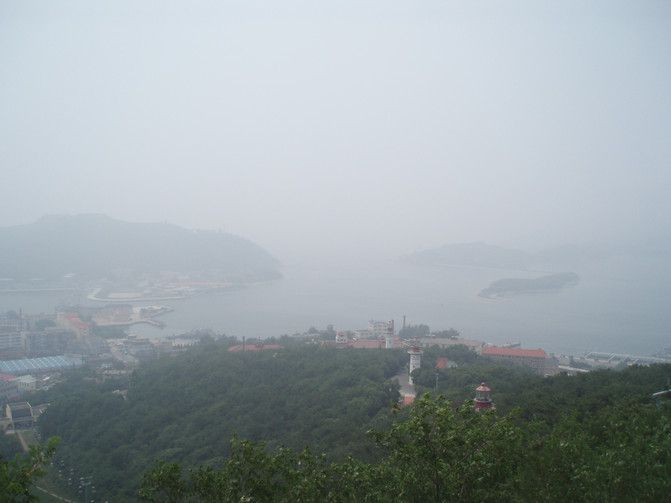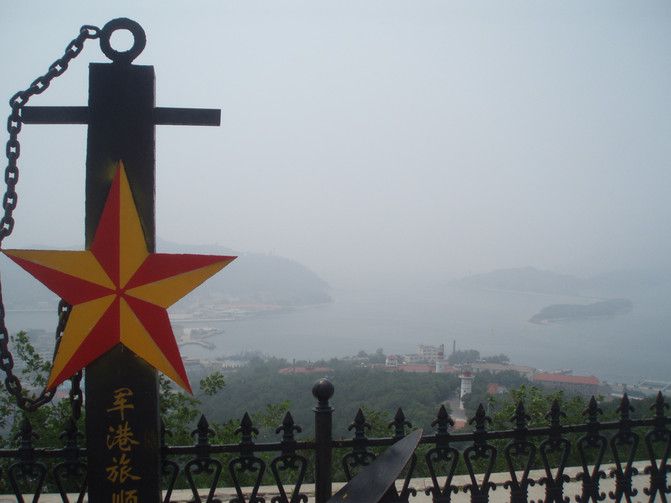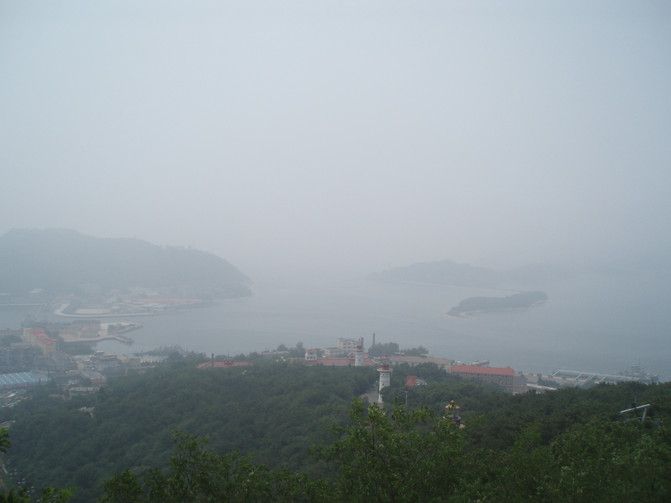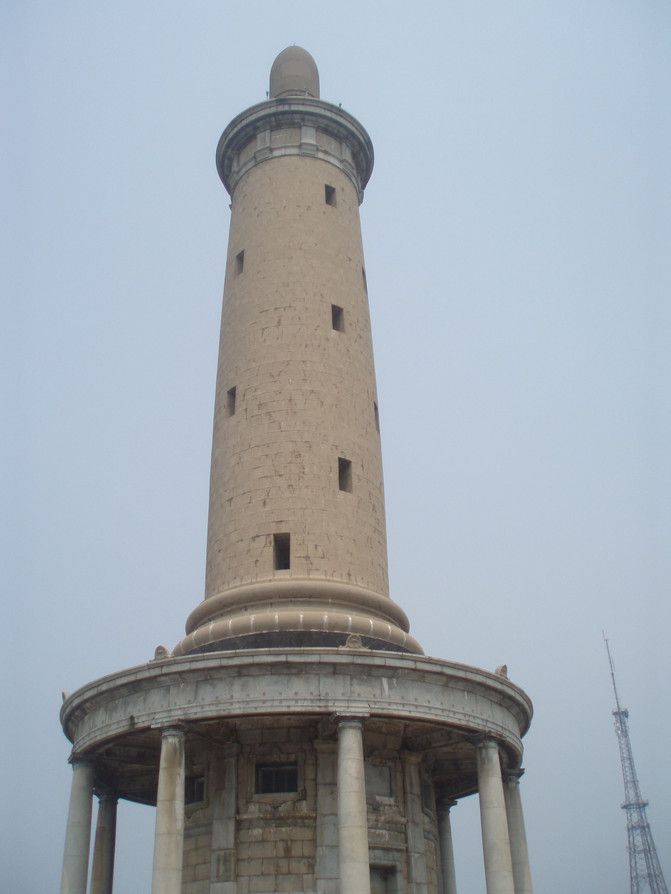Published on July 13, 2014 20:13

Lushun, also known as Lushunkou, is located at the southernmost tip of Liaodong Peninsula. It was also known as "mashijin" in Jin Dynasty, "Duli town" in Tang Dynasty, and "SHIZIKOU" in Yuan Dynasty. In 1371, Zhu Yuanzhang, the emperor of Ming Dynasty, sent two generals Ma Yun and ye Wang to guard Liaodong by sea. Because of the smooth sea journey, SHIZIKOU was renamed Lushunkou. Originally, Lushun and Dalian were called LvDa city. After 1981, Lushun became Lvshunkou district under the jurisdiction of Dalian city. On the morning of July 1, 2014, I went from Dalian to Lushun, a seaside town.

When I got to Lushun, I went out of my way to climb the top of Baiyu mountain on the North Bank of Lushun military port to overlook the scenery of Lushun military port. But see Lushun Port, the mountain ring protection, port entrance to Southeast, East is the majestic Gold Mountain, the west side is tiger tail Peninsula, southwest is lofty old fellow iron mountain, between golden mountain and tiger tail Peninsula, is from two mountains confrontation and become nearly 300 meters only a 91 meter fairway exit, that is known as Lushunkou (lion mouth), known as "the wonders of the world". Such a natural victory is an ideal place to build a military port.

In 1880, the Qing government set up the Beiyang Navy here, built a military port, built a fort, built a dock, and built a camp. Lushunkou became the largest military fortress in Asia at that time, which was formerly known as Port Arthur or Port Arthur in the West. Later, Russia and Japan successively took it as a military port. Today, Lushun Port is still an important base for the Navy's North Sea fleet.

Lushun military port is close to a closed Bay. The winding tiger tail Peninsula divides the whole bay into East and West ports. It is said that the import and export channel between Huangjinshan and laohuwei peninsula can only pass through one large warship at a time, which is easy to defend and difficult to attack strategically. In those days, there were fort on the mountains on both sides of the channel, and the firepower crossed into a network, which made it difficult for enemy ships to approach. Therefore, no matter the Sino Japanese war or the Russo Japanese War, the Japanese army did not attack Lushun from the sea, so some military experts said: "Lushun is a port, Natural victory means that there are thousands of troops, which can never be broken.

Baiyu mountain, more than 130 meters above sea level, is the symbol of Lushun. Originally, it was called Xiguan mountain. When Li Hongzhang visited Lushun in the late Qing Dynasty, he said that "if there is gold, there must be Baiyu", so he changed its name to Baiyu mountain. There is a 66 meter high tower on the top of the mountain, which was built by the Japanese to comfort the souls of the dead after the Russo Japanese war. It was originally called "biaozhong tower". It is said that all the building materials were taken from Japan, and the tower is now renamed Baiyu tower.
Not far from the tower is the Naval Weapons exhibition hall, where there are navy decommissioned ships such as seahawk-1 torpedo boat, aircraft and naval guns for visitors to visit.
Go down the mountain to Lushun railway station. Lushun railway station is the terminal station of the South Manchuria Railway branch line built during the period of tsarist Russia's occupation of Lushun. It was put into operation on July 14, 1903.
This Russian style wooden building is unique in shape, with green straw hat shaped oval spire, full of feathery tiles, exquisite details, full of exotic charm, Russian style white walls and green windows. It is the most completely preserved European style building along the Northeast Railway, and there is also the most completely preserved European style platform in the station. This building with historical value is still used as a railway station.
Leave Lvshun railway station and stop at Lvshun victory tower. This tower was built before the Soviet army withdrew from Lushun. It is 45 meters high and has a pentagonal shape. It is made of granite and has a neat and beautiful appearance. Lushun victory tower. It was built in 1955. The base columns of the tower are composed of five hexagonal columns and ten octagonal columns. The upper part of the tower is decorated with various patterns made of bronze. On the top 15 meters high copper gold-plated spire, there is a Red Star Tower emblem surrounded by exquisite rice ears, symbolizing victory and friendship. Distributed on the five sides of the tower, it looks elegant and solemn.
Leave victory tower and come to the former site of Russo Japanese prison. This prison was built in 1902-1904 by Tsarist Russia. During the Russo Japanese War, it served as a military camp and a field hospital for tsarist Russia. After the end of the Russo Japanese War, in 1907, the Japanese carried out a large-scale expansion. The number of prison cells increased from 85 to 253. At the same time, 15 workshops were built in the hospital to force prisoners to produce military supplies and daily necessities for them. Around the prison, a 725 meter long and 4 meter high red brick wall was built, and power grids and guard towers were set up. Most of the prisoners are Chinese, but there are also Korean and Japanese. Among them is an chonggen, a Korean volunteer who assassinated ITO Bowen in Harbin. It is impossible to calculate how many people were killed here. It is said that between 1942 and August 1945 alone, more than 700 people were hanged and tortured to death.
Lushun has carried too many national disasters and humiliations in China. In 1894, during the Sino Japanese War of 1894, when the Japanese army captured Lushun, the city carried out four days and three nights of crazy massacre. More than 20000 people in the city were killed, and only 36 people survived as corpse bearers. Lushun is really a place for patriotism education.
It was afternoon before I knew it. I wanted to go to the Nanzi magazine and the electric eye battery in the area of Huangjinshan. I heard that they had been sealed up and could not visit, so I gave up. He then returned to Dalian by car, ending his half day trip to Lushun.
